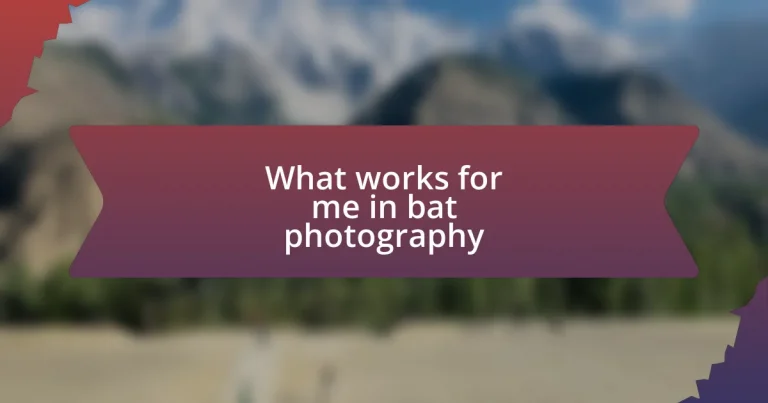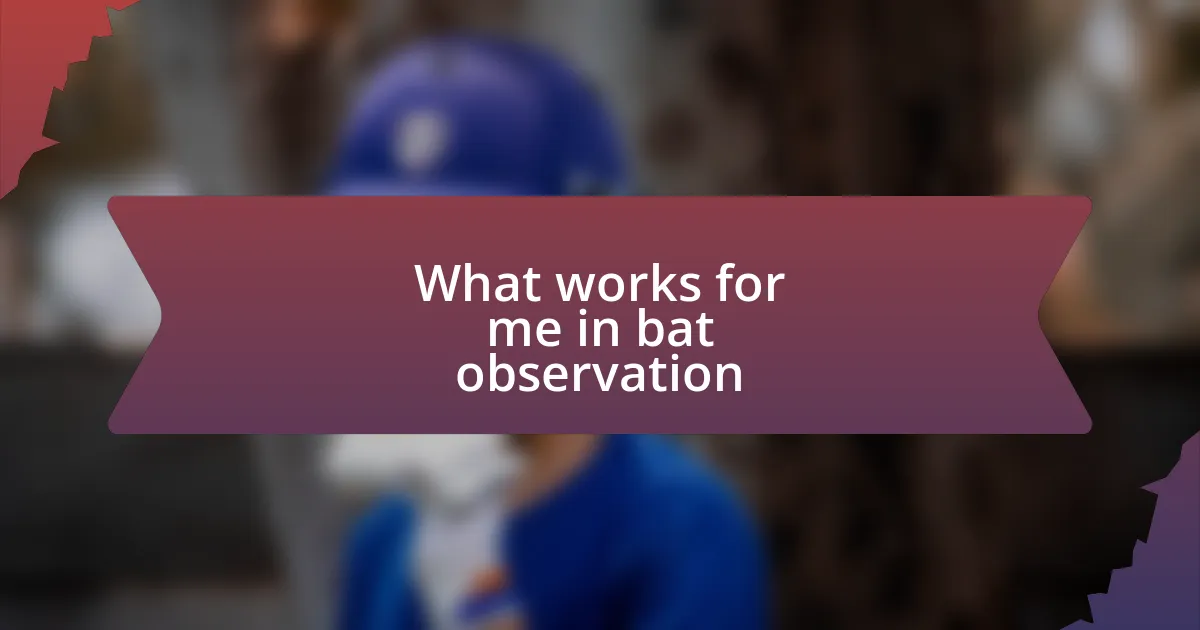Key takeaways:
- Understanding the nocturnal nature of bats and using the right camera settings and gear, like a fast lens and tripod, are crucial for successful bat photography.
- Timing your photography sessions during twilight and observing bat behavior can significantly enhance picture quality and capture exciting moments.
- Post-processing techniques, such as adjusting exposure, color correction, and cropping, are essential for elevating bat images to their full artistic potential.
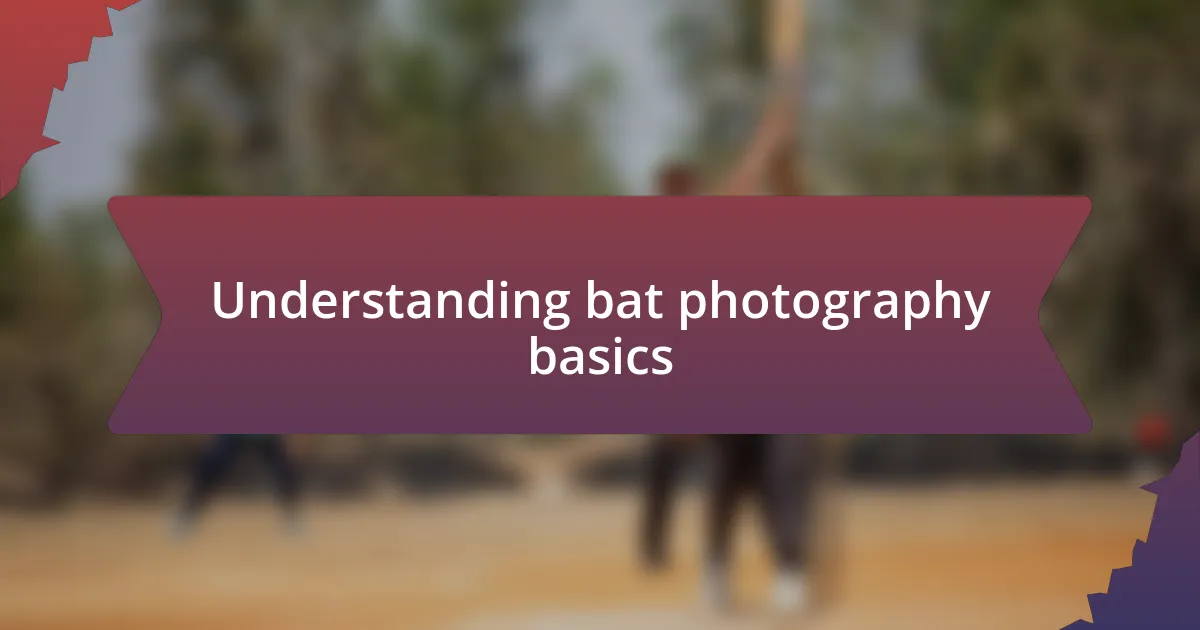
Understanding bat photography basics
When I first ventured into bat photography, I quickly realized that understanding their nocturnal nature is crucial. These creatures are active in low-light conditions, so familiarizing yourself with your camera’s settings for low-light photography can make a huge difference. Have you ever stood in darkness, waiting for a brief flutter and felt your heart race? That anticipation is both thrilling and challenging.
Choosing the right gear is essential for capturing bats effectively. A fast lens with a wide aperture (like f/2.8) allows more light to hit the sensor, improving your chances of snapping a clear image. I remember my first night out, struggling with my old camera and a regular lens, feeling the frustration as the scene unfolded before me in blurry swirls. Investing in a quality lens transformed my experience, allowing me to capture the beauty of bats in flight, something I had previously only dreamed of.
Timing is another critical aspect of bat photography. Observing their behavior can reveal patterns; for instance, I’ve found that bats are often most active at dusk. Knowing when they emerge has significantly improved my success rate. Just think about the excitement of standing there, camera ready, as the sun dips below the horizon, and suddenly, you see those silhouettes darting overhead. It’s a feeling like no other, turning a simple evening into an unforgettable adventure.
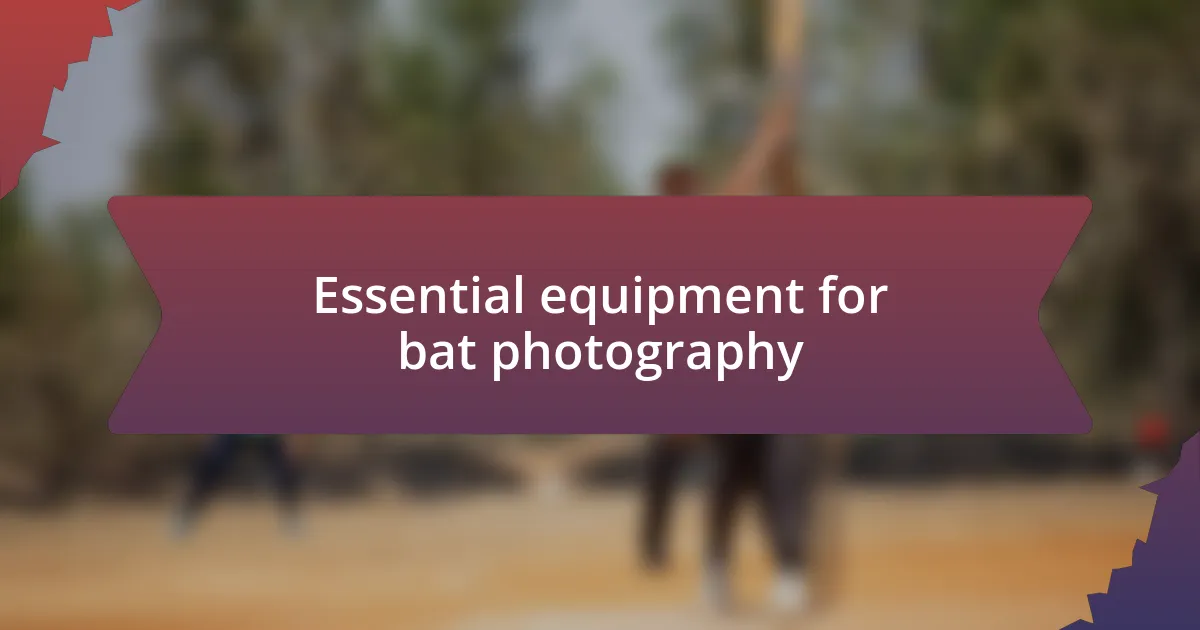
Essential equipment for bat photography
When it comes to essential equipment for bat photography, having the right tools can make or break your experience. I highly recommend investing in a sturdy tripod. During those long hours at dusk, when your hands may become unsteady, a tripod provides the stability necessary for longer exposure times. I remember a particular night when I noticed a bat feeding just above the water’s surface. With my tripod, I was able to capture sharp, detailed images that later reminded me of how magical that moment was.
In addition to a quality camera and lens, consider having a good flashlight or headlamp. This is particularly helpful for navigating to your shooting location as well as setting up your gear while it’s still dark. I once fumbled around in the dark, trying to find my way, only to miss an incredible scene. Now, I always carry a reliable light source that helps me in those critical moments. Don’t underestimate the power of a well-planned setup.
Another piece of equipment that can enhance your bat photography is a remote shutter release. It allows you to take pictures without physically touching the camera, minimizing vibrations that could lead to blurry images. I recall the first time I used one; I was so pleased to see the sharp images of bats weaving in and out of my frame. Each piece of equipment undeniably contributes to a rewarding experience as you seek to chronicle the elegance of these unique creatures.
| Equipment | Purpose |
|---|---|
| Camera | Capturing high-quality images in low light |
| Fast lens (e.g., f/2.8) | Allows more light and improved focus |
| Tripod | Provides stability for long exposure shots |
| Flashlight/Headlamp | Helps navigate dark areas |
| Remote shutter release | Reduces camera shake for clearer images |
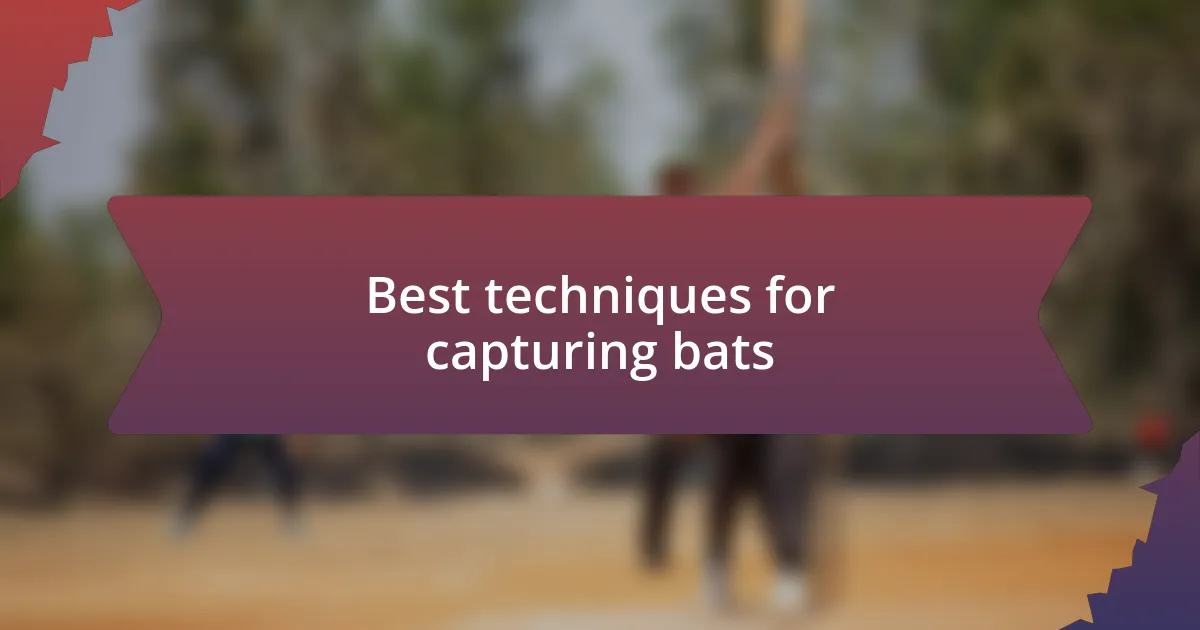
Best techniques for capturing bats
Capturing bats requires a blend of technique and patience. One effective method is to shoot during twilight, just as the sun dips below the horizon. This is when bats become more active, and the soft lighting can create stunning images. I recall standing by a riverbank, captivated by the delicate ballet of bats against the fading light. That experience taught me how essential timing is in this hobby.
To help you get started, here are some of the best techniques I’ve found useful in my bat photography journey:
- Use a fast shutter speed: This freezes the movement of bats, preventing motion blur and ensuring clarity.
- Shoot in RAW format: This gives you more flexibility in editing, especially in low-light conditions.
- Focus on areas with light sources: Bats are often attracted to insects near street lamps or other lights. Positioning yourself nearby can lead to captivating shots.
- Practice panning: This technique allows you to follow the bats’ flight path, resulting in dynamic, motion-filled images.
- Be patient and quiet: Bats can be skittish. Staying still and silent often leads to longer viewing and shooting opportunities.
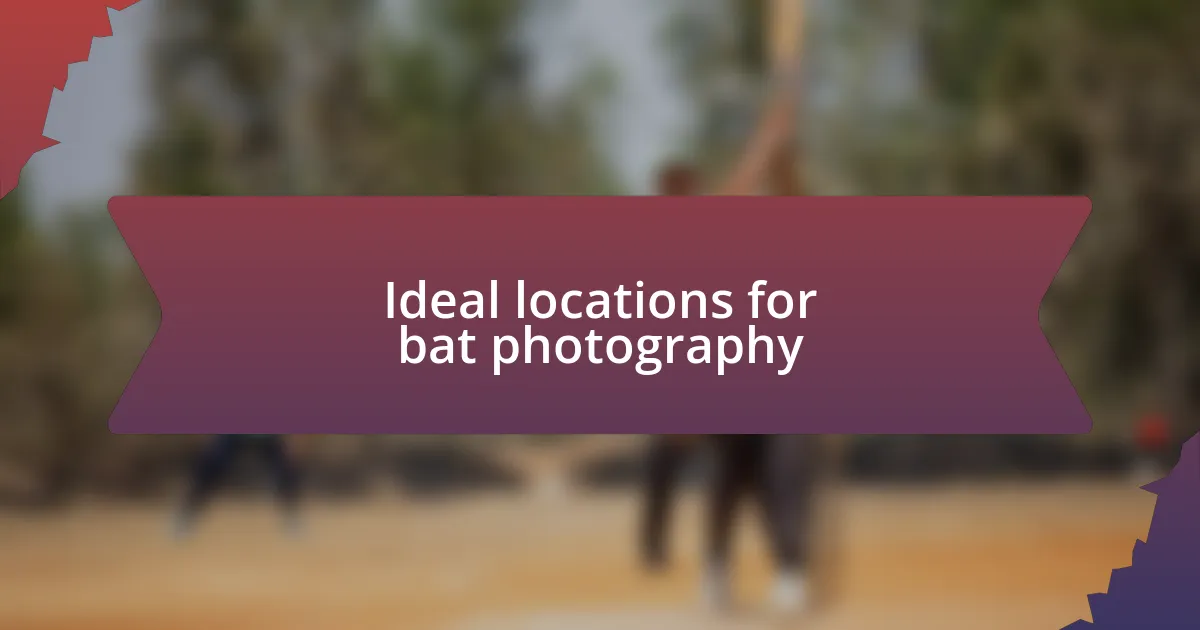
Ideal locations for bat photography
When it comes to selecting ideal locations for bat photography, I’ve found that natural environments like forests and wetlands provide stunning backdrops and abundant wildlife. These areas often house a variety of bat species that dart gracefully through branches or over water. I’ve spent evenings beneath the sprawling canopies of oak trees, where the combination of twilight and the rustle of leaves added an almost magical ambiance to the experience.
Additionally, urban settings with streetlights can be surprisingly fruitful. I remember one night shooting near a park populated with lampposts that illuminated the sky. The bats flocked to the insects swarming around the lights, creating a mesmerizing display. It made me realize how blending nature with human elements could unlock unique photographic opportunities.
Finally, caves and abandoned buildings are worth exploring. Bats often roost in these locations, especially during the day. I once ventured into a dilapidated warehouse and was amazed to find a family of bats clinging to the rafters. The challenge of capturing their stillness contrasted beautifully with the lively action of their evening flights. Have you ever considered how these diverse environments can influence your bat photography? The stories they tell through your lens can be truly captivating.

Timing your bat photography sessions
Timing your bat photography sessions is crucial for capturing the most stunning images. I’ve learned that dusk is the ideal time, just as the sun begins to dip below the horizon. That twilight period creates a warm glow, and I recall one evening when I timed my shots perfectly, watching as the bats emerged from their roosts, silhouetted against the soft pastel sky—it was simply magical.
I’ve also noticed that the moon phases can impact bat activity. On nights when the moon is full, I’ve found that the light can be both a blessing and a curse. It can illuminate the bats beautifully, but their feeding patterns may change. When I’ve encountered this, it got me thinking: should I adjust my plans for the night? I now consider moonlit nights for different styles of photography, blending the natural light with the energetic flight of bats for truly unique captures.
Timing isn’t just about day or night; it’s also about seasons. During migration periods, my heart races just thinking about the potential for unique shots. I remember one spring evening that felt electric as bats flocked overhead, their movements chaotic yet graceful. Have you ever experienced that thrill of witnessing nature’s rhythm and capturing it through your lens? That is when the art of bat photography truly comes alive.
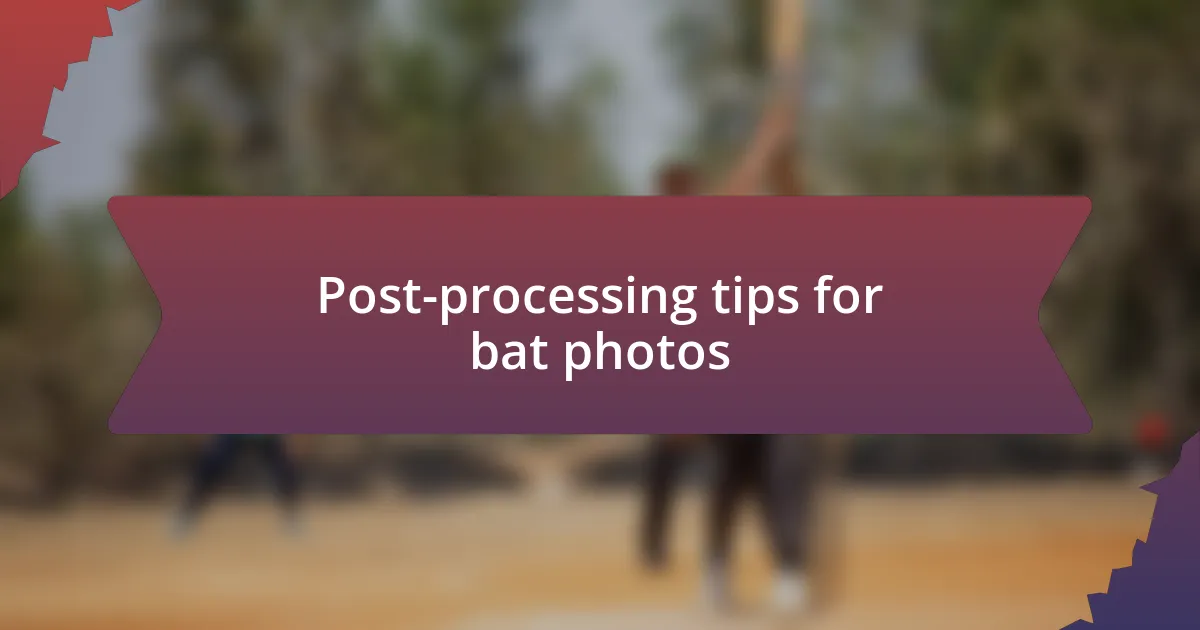
Post-processing tips for bat photos
Post-processing bat photos can elevate your images from ordinary to extraordinary, transforming those fleeting moments into breathtaking art. When I work with my bat images, I often start by adjusting the exposure and contrast. I remember the first time I enhanced an underexposed shot; it felt like breathing new life into the image as the delicate wing patterns emerged, revealing nuances I hadn’t noticed before.
Color correction is another essential step in my workflow. Bats often appear muted against night skies, and adjusting the colors can add vibrancy that brings the scene to life. I once edited a photo where the bats blended into the deep blue night, but with a few tweaks, they jumped off the screen, almost dance-like against the horizon. Have you ever felt that thrill when a simple adjustment reveals hidden beauty?
Finally, don’t shy away from cropping your photos to highlight the bats’ movements. I’ve found that tighter framing can create a sense of drama and focus. There’s something exhilarating about taking a wide shot and honing in on a single bat in flight—it’s like capturing a moment of pure freedom. What are your favorite cropping techniques? Exploring those can make your bat photography incredibly impactful.
